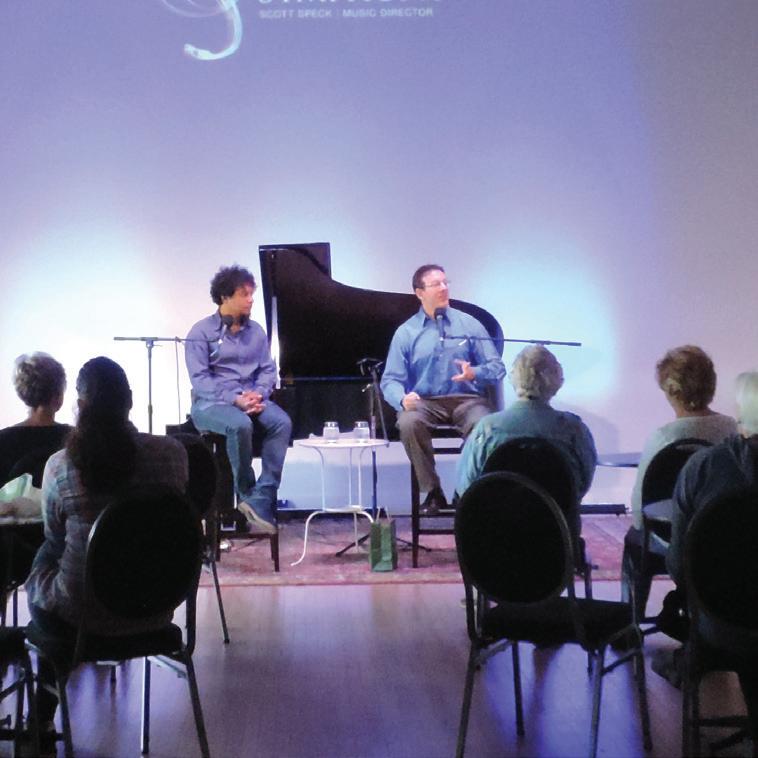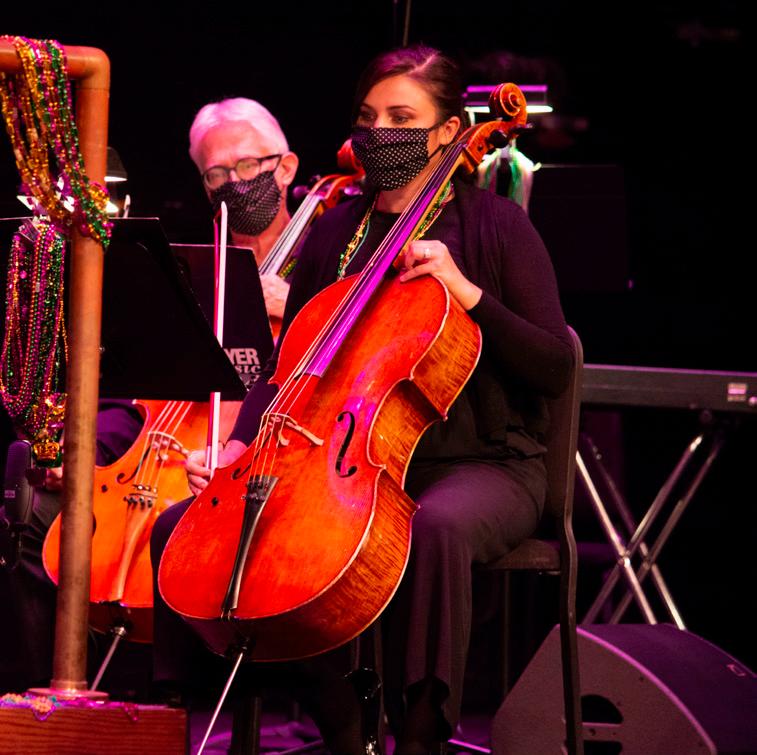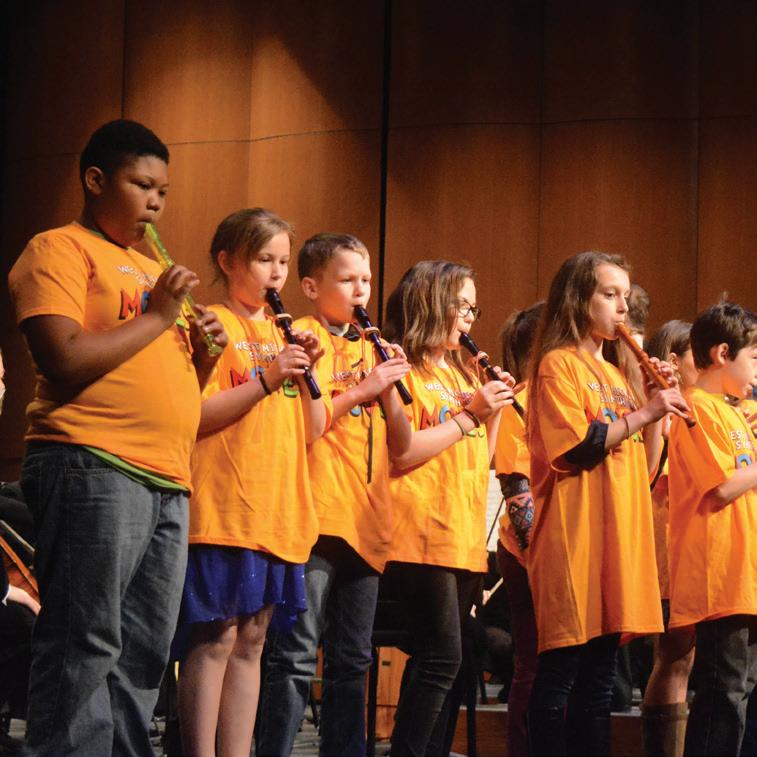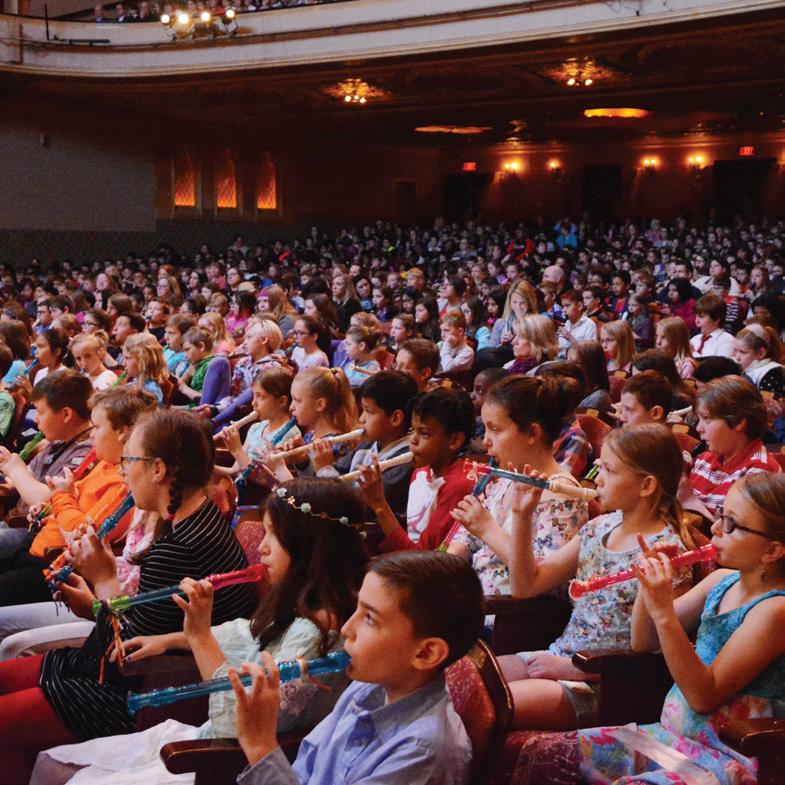WEST MICHIGAN SYMPHONY






















We are a catalyst for a music-infused West Michigan: leading, facilitating, connecting and collaborating with the community to stimulate cultural vibrancy, inclusivity and pride of place.
West Michigan Symphony connects and enriches our diverse community through the transformative power of music.
We fulfill this primarily through three core offerings:
• Professional, live symphonic performances in a welcoming environment.
• The Block, a gathering space that sparks curiosity, inspiration and fellowship through the shared experience of uncommon live music.
• Music Education that enriches the lives of children and adults through exploration, participation and performance.
• Collaboration. We believe the whole is greater than the sum of the parts. We will collaborate internally— among the staff, musicians, board and volunteers—in order to achieve our mission. We will collaborate externally—with other organizations in our sector and community—in order to transcend it.
• Efficiency. We will do our work well, successfully, and with optimal use of our primary resources: time, talent, and money.
• Inclusivity. We exist to share the joy of music with all our community. We will strive to reflect inclusivity throughout our organization, and to foster a welcoming environment at our events.
• Professionalism. We will convey deep respect for our patrons and our work through competence, reliability, integrity, demeanor and appearance.
• Transparency. We will operate and communicate in a way that reflects openness, honesty and accountability.
• Fun. We exist to bring hope and pleasure into people’s lives. We will take our work seriously, but never ourselves!
West Michigan Symphony’s 2020-2023 Strategic Plan is being developed in two phases. Phase I took place from July to December, 2019. Staff and board members from WMS and its subsidiary, The Block, began by conducting a SWOT Analysis (Appendix I) over multiple summer sessions by both boards and the staff.
In October, a meeting of the boards and staff, facilitated by consultant Paula Kendra, was held at the Annis Water Resources Institute. This session included a review of the SWOT and a brainstorming process that resulted in drafts of Vision and Mission statements. A Task Force consisting of staff and board members from both organizations was appointed to carry the work forward.
The group, meeting biweekly from mid-October through mid-December, finalized a Vision Statement encompassing the broader organization. It elected to craft separate Mission statements for WMS, The Block, and the menu of education programs mounted by each division.
The Task Force then began developing the topline goals of the Strategic Plan. We spent an entire meeting on a “blue sky” generative discussion that resulted in a white board full of creative ideas for achieving the vision.
Kendra and Executive Director Andy Buelow then shaped the results into a series of draft goals (broad statements of what we want to achieve) and grouped them in six pillars:
• Artistic Vibrancy
• Music Education
• Community Engagement
• Audience Development
• Fund Development
• Infrastructure
The Task Force reviewed the results, made a number of important changes, and then adopted the final resulting set of goals. The staff was then charged with drafting objectives (quantifiable outcomes) to accomplish each goal. The group met for a final session in mid-December to review, modify, and ultimately adopt the resulting series of objectives. This marked the completion of Phase I.
Phase II will consist of developing the work plans—in the form of strategies and tactics—within each objective. In some cases this will be a staff-driven activity; in other areas, one of the WMS Board’s three standing committees, or the full Block board, will take the lead. The entire strategic plan will be divided up into annual work plans for completion by 2023. The Board will review progress at least biennially.
For a diagram outlining the Strategic Planning hierarchy of steps, see Appendix II.
GOAL I:
Plan Programming that attracts and inspires people at all levels of familiarity with the art form
• Develop an inclusive artistic planning model that guides performance outcomes
• Balance mission-critical works with “single-ticket friendly” programming
GOAL II:
Transform concerts into events that captivate audiences and become the “talk of the town”
• Broaden audience touchpoints during concert week beyond the performance itself
• Plan at least one annual marquee or signature event that stretches our capacity: artistic, production, listener or other
Artistic Vibrancy: a framework for assessing the organization’s impact in a holistic manner, beyond static definitions of excellence. It provides a tool for gathering useful internal and external feedback, facilitating reflection, growth and change. For an outline of our Artistic Vibrancy Framework, see Appendix III.
GOAL I:
Work toward eliminating barriers to participation in music education activities for all the community’s youth
• Develop marketing strategies to reach underserved youth with existing education programs
• Begin the collaborative work towards creating an El Sistema type program in Muskegon
• Develop and identify financial support to allow free access to education programming
GOAL II:
Expand program geographic footprint to include under-served areas of West Michigan
• Identify under-served geographic areas and develop relationships with new school districts
• Bring a WMS Education program(s) to an area we currently do not reach
GOAL III:
Develop adult programs that deepen music appreciation and participation
• Establish a ‘rusty musicians’ program for adults who play(ed) an instrument
• Maximize opportunities for additional adult engagement around current concerts
• Develop marketing strategies to inspire these adults to become season ticket holders
El Sistema (the system): An instrumental music program for marginalized children, originating in Venezuela and championed in the US by LA Philharmonic conductor Gustavo Dudamel. El Sistema-inspired programs offer free classical music education that promotes human opportunity and development for students from underserved backgrounds. El Sistema youth orchestras provide intensive weekly after-school music instruction and free use of an instrument in a supportive, nurturing environment.
GOAL I: Expand relationships and relevance through strategic collaborations
• Be a visible leader at the table as the community strives to address its challenges and build widespread, shared prosperity
• Partner with other area arts and culture organizations to elevate sector relevance through creative placemaking
GOAL II:
Work toward diversifying the organization at all levels to accurately reflect the community
• Build an open Board, staff and volunteer culture that welcomes and embraces a plurality of backgrounds, life experiences and ethnicities
• Plan concert seasons to reflect diversity through programming choices and guest artists
• Support local, regional and national efforts to increase access to music opportunities
Community engagement: a dynamic relational process that facilitates communication, interaction, and involvement between an organization and a community for a range of social and organizational outcomes.
K.A. JohnstonGOAL I:
Expand organizational visibility and reach; cultivate new audiences
• Develop programs and incentives that appeal to younger and more ethnically diverse audience members
• Expand marketing initiatives that target neighboring communities
• Overcome attendance barriers for classical aficionados who don’t currently attend (“aware non-attenders”)
GOAL II:
Build audience loyalty and sense of community
• Optimize patrons’ entire concert experience—from point-of-sale to post-concert (concierge approach)
• Make Symphony performances “the place to be” in Muskegon
• Develop ancillary events and benefits that acknowledge and celebrate milestones in patrons’ relationship to organization and deepen their identification with WMS
To attract and retain new audiences, arts organizations need to stop selling excellence and start brokering relationships between people and artists.
Diane Ragsdale, Andrew W. Mellon Foundation
For a diagram of the Patron Loyalty Ladder, see Appendix IV
GOAL I:
Expand and diversify the donor base
• Increase target constituencies’ awareness and understanding of WMS’s impact on the community and the need for support beyond ticket revenue
• Constantly cultivate and reach out beyond the core to community influencers and thought leaders, new foundations and corporations, and ticket buyers who don’t donate
GOAL II:
Build lasting, committed relationships with annual donors
• Systemize but personalize: develop systems that normalize and reinforce constant “touching” of donors with personal, authentic contacts.
• Instill an “ask, thank, report, thank, report, ask” discipline and culture throughout organization—led by the staff but spanning the Board and artists as well.
• Acknowledge committed, stretch giving with access to leaders and artists, a personal connection to the orchestra (not tchotchkes!)
GOAL III:
Grow organizational endowment
• Build out a full Endowment program that provides donors with options—i.e. Endowed Chairs, designated projects and focus areas (Education, Guest Artist Fund, etc.)
• Mount a capital/endowment campaign to raise $5 million in outright gifts and pledges
• Create a consistently visible Legacy Giving program that inspires confidence and generates regular bequests and other planned gifts
Our mission—to provide vibrant music performances and services—must be differentiated from our economic driver: the unrelenting development of community support through systematic, persistent engagement over time.
Bruce Coppock, retired president, Saint Paul Chamber Orchestra
For a summary of our Fund Development Strategy, see Appendix V
GOAL I:
Build and retain the human capital needed to achieve this plan
• Maximize morale, skills and efficiency of current staff; add personnel to expand capacity for sustained community engagement, development, and other needed areas
• Grow and train volunteer corps and develop programs to motivate, recognize and reward them
• Provide regular training, and develop programs and systems, to renew and enhance Board leadership capacity
GOAL II:
Ensure access to, protect, and optimize venues and staging spaces
• Work with Community Foundation for Muskegon County and other partners to provide stewardship, maintenance and oversight of Frauenthal Center
• Improve/enhance concert experience (sight, staging and comfort) at The Block; work proactively with neighboring venues to protect sound integrity
• Establish a regular summer performance presence that complements and enhances other community activities
GOAL III: Refine and optimize Business Model
• Grow endowment capable of generating earnings equivalent to at least 15% of budget
• Build reserve fund equivalent to 3 months’ of average operating expense
• Enhance earned revenue and reduce occupancy expenses at The Block
Rhonda Bogner Chief Financial Officer
Ryan W. Bryker Resources Committee
Andy Buelow Executive Director
Jan L. Deur Governance & Resources Committee
Dr. Peter Kurdziel Advancement Committee
Kate McClure Patron Services Manager
Keely Payne Art Director & Marketing Manager
Mary L. Price Advancement Committee
Thomas Schaub Advancement Committee
Gabe Slimko Vice President of Operations & Personnel Manager
Emma Torresen Block Advisory Board
Kerri VanderHoff Block Advisory Board
Karen Vander Zanden Director of Education & Corporate Engagement
• Long history and solid reputation within the community and region
• Engaging personality, national profile, and artistic strength of Music Director Scott Speck
• Excellent musicians who value their association with the organization
• Experienced, knowledgeable and dedicated staff team
• Engaged, enthusiastic, well-connected Board
• Access to the Frauenthal, a high quality venue
• Uniqueness, flexibility and great acoustics of The Block
• Loyal, devoted audience and generous donor base
• Far-reaching and well-established education programs
• Generous, long-term benefactors
• Nimble, non-union orchestra
• Willingness to reach outside the organization for help, e.g. consultants, marketing
• Limited size of admin staff: people wearing multiple hats, no dedicated Development staff
• Small pool of volunteers, lack of ethnic and age diversity
• Inadequate endowment, little reserves, and heavy reliance on a few top donors
• Shrinking, aging subscriber base, insufficient single ticket pool to replace them
• Shallow brand penetration throughout the market—many people do not know or understand the “WMS story” and don’t know about The Block
• Physical constraints of The Block: limited revenue potential, sound bleed problems, poor sight lines on main floor, uncomfortably crowded feeling when sold out
• Limited capacity for increased community engagement due to music director and musicians being mostly from out-of-town
• No inclusive, organization-wide role, including Board involvement, in the “artistic roadmap”
• Half market – limited geographically by Lake Michigan
• Shadow market of Grand Rapids
• No programming to reach summer tourists
• Little control over performance space – Frauenthal
• Only 8 concerts per year, primarily classical music
• Lose money on every concert
• Growth/rebirth of Muskegon and especially downtown—opportunity to cultivate new audiences
• Fresh leadership in cultural and other downtown organizations—window for collaboration and cooperation to reach wider market base
• Work with community leadership to change Muskegon’s “story” and attract more regional “cultural tourists” from Tri-Cities, White Lake, areas west of GR
• 80th Anniversary a new potential inflection point for WMS
• Purchase of Russell Block Building may provide potential for expanded presence/footprint
• Play a leadership role in community’s focus on diversity, equity & inclusion
• Greater demand and need for youth education programs/building audience of the future
• Become the leading cultural organization for donor development and fund raising
• Adult education
• Younger consumers are interested in hands-on, active participation in the arts
• Unreached community segments
• New businesses/businesses that have never been asked or previously declined opportunity to sponsor
• Corporate season tickets
• Realtor tickets for new home buyers
• Making performances more of a social event for patrons
• Aesthetic education
• Summer tourists
• Retirees, families and minorities not being well served downtown
• Aging audience and donor base and insufficient younger patrons to replace them
• Lack of interest by younger generation in classical music, declining attendance at live events nationally, changes in lifestyle, increased resistance to subscribing
• Continuous fund drives in community / potential risk of donor fatigue
• Competition for time and donations from other organizations
• Gravitational pull of Grand Rapids Symphony / funneling off potential audience
• Looming sale of Block Building and existing environmental challenges from fellow tenants
• Music education disappearing from schools—where will our future audience come from?
• Accumulated maintenance issues, lack of a sustainable business model for Frauenthal
• Increasing parking issues as downtown becomes more vibrant
• Declining demand for live music performance – reliance on technology for entertainment access
Quantifiable,

Short

The Artistic Vibrancy Framework was first outlined by the Australia Cultural Council in 2009 as a way for arts organizations to plan, measure and assess their artistic impact in a holistic manner. Recognizing that “the impact of art cannot be wholly explained with numbers, or narrow definitions of ‘excellence,’” the ACC framework identified an artistically healthy organization as one that: supports the development of art and artists; engages and connects with audiences and communities; and contributes to a vibrant society and culture.
The American arts marketing firm Wolf/Brown Consultants introduced the concept in the U.S. the following year. “If the audience is a reflection of what’s on stage, then what use is talking about audience development without talking about programming?” asked Alan Brown. “At the very heart of every arts organization is a process of conceptualizing and curating artistic content. It is the most essential process.”
Based on the ACC and Wolf/Brown agency models, West Michigan Symphony has adopted the framework below to guide its artistic activities. In our program and orchestra developmental planning, we will strive for:
• Clarity on desired programming outcomes at the board level (i.e., what is the organization hoping to achieve by offering programs?)
• Regular debate as to how to balance the commitment to artistic ideals with community relevance (i.e. mission-critical projects vs. blockbuster and single ticket-friendly programming)
• Constant striving for artistic excellence in performance and production
• Consideration of impact on audience (i.e., content relative to the musical literacy of audience)
• Engagement with other arts and non-arts organizations (and their constituents) through programming partnerships
• A demonstrable commitment to continuous improvement on the part of artists and artistic staff, including receptivity to critical feedback on programming and artistry
• An inclusive and consultative program planning process
• A full pipeline of new programming ideas matched to constituencies and resources
• Policies and capital for managing artistic risk
• Innovation in the preservation and development of the art form
• Development of artists of all skill levels
If the audience is a reflection of what’s on stage, then what use is talking about audience development without also talking about programming?
Alan Brown, Wolf/Brown ConsultantsWMS’s audience development program includes regular, systematic prospecting for new customers. One of the biggest weaknesses facing WMS in the past decade has been the size of its single ticket buyer pool, which until recently has been too small even to replenish normal subscriber attrition. Now that this has been addressed, we must still continue to attract new ticket buyers through brand awareness advertising and prospecting.
However, marketing to new audiences is costly, and this investment is largely wasted without audience development practices that work at all levels to maximize patron retention through building their loyalty to the organization.
Increasing patrons’ loyalty is the best way to ensure long-term, sustainable audiences and revenue. Through data, WMS strives to follow every step on the patron’s journey, from first time attendee to advocate/investor. With the help of our TRG counsel, we create and implement strategies to make patron engagement stronger, longer, and lasting.
Exposure to great music leads to involvement; involvement to engagement; engagement to passion; passion to philanthropy.
Bruce Coppock New Single Ticket Buyer Repeat Ticket Buyer Multi Ticket Buyer Subscriber/ Member DonorEven the most sophisticated organizations sometimes lose sight of the fundamental concepts that shape good fundraising. We can all benefit from periodically refreshing our understanding of the field’s best practices, which are grounded in research.
Here are six overarching concepts that we use to shape our fund development strategy:
• Spend more time on seeking individual contributions than sponsorships or grants. Individual donors are more likely to give on an unrestricted, sustained basis.
• Pay the most attention to the people closest to the organization, not those outside. It is more effective to focus on those who already believe in our cause and are already contributing toward it.
• Prioritize retaining-upgrading current donors and re-activating lapsed donors over acquiring new donors. See above.
• Focus attention on donors who have given the most money. Treat every donor with respect and honor—while concentrating our time and resources on those whose giving level sustains and furthers our mission.
• Invest more energy deepening donors’ relationships with our work than asking. Ask only when we know people are ready to say yes. This is why it is called fund development. While small, one-time gifts result from letter appeals and special events, sustained giving comes from our nurturing of advocate/investors.
• Emphasize lower-cost-per-dollar-raised methods over high-cost methods. The highest-cost method of all is the special event, while the lowest-cost is the direct major gift appeal.
Adapted from Boards on Fire! Inspiring Leaders to Raise Money Joyfully
 By Susan Howlett
By Susan Howlett








360 W. Western Avenue, Suite 200 Muskegon, MI 49440 westmichigansymphony.org 231.726.3231
